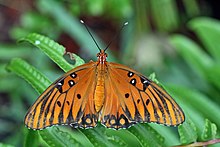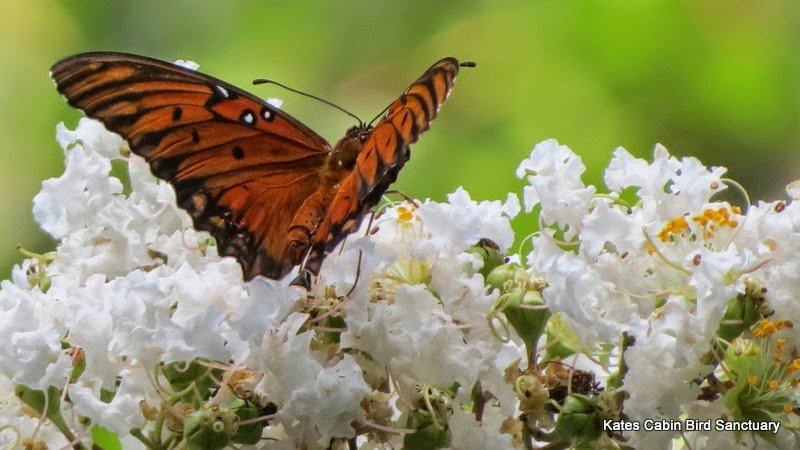
Hi Everybody!!
It has been very easy to count my summer butterflies this year. I have had one, this one pictured. This is a Gulf Fritillary. I have shared info below from Wikipedia about this butterfly. Always, I have had hundreds of butterfly visitors until the droughts of the last 3 years. This has been the best summer as we had rain and slightly cooler temps for the first time in 4 years. The butterflies have not recovered in this area. I hope you are seeing increased numbers in your location. Please photograph some butterflies and post them on G+ so we can see them. I can tell you it is Fun chasing butterflies around for a photo! Enjoy!!





https://en.wikipedia.org/wiki/Gulf_fritillary
Gulf fritillary
From Wikipedia, the free encyclopedia
| Gulf fritillary | |
|---|---|
 | |
| Upperside | |
 | |
| Underside | |
| Scientific classification | |
| Kingdom: | Animalia |
| Phylum: | Arthropoda |
| Class: | Insecta |
| Order: | Lepidoptera |
| Family: | Nymphalidae |
| Tribe: | Heliconiini |
| Genus: | Agraulis (Boisduval & Le Conte, 1835) |
| Species: | A. vanillae |
Description[edit]
The Gulf fritillary is a medium to large butterfly, with a wingspan of 6–9.5 cm (2.4–3.7 in). Its underwings are buff, with large silvery spots.[1] It takes its common name from its migration over the Gulf of Mexico.
The Gulf fritillary is commonly seen in parks and gardens, as well as in open country. Its range extends from Argentina north through Central America,Mexico, and the Caribbean to the southern United States, as far north as the San Francisco Bay Area on the west coast. It is occasional farther north.[2]
Larva[edit]
The larva is a caterpillar which grows to approximately 4 cm (1.6 in) in length. It is bright orange in color and covered in rows of black spines. The spines are soft to the touch and do not sting, but the larva is poisonous if eaten. The larva feeds exclusively on species of passionflower, such as maypop (Passiflora incarnata), yellow passionflower (P. lutea), and running pop (P. foetida).
Black and orange stripes warn predators of the toxicity of the caterpillar which protects it from predators.[3]Many birds avoid it.[4] Some specialized insects such as paper wasps and pragmatists have been observed feeding on it, however, and larger caterpillars sometimes eat smaller ones. This species belongs to the "orange" Batesian mimicry complex.
The cultivation of passionflowers has enabled the Gulf fritillary to extend its range, into California, for example.
Chrysalis[edit]
When the time comes for the caterpillar to create its chrysalis it turns a greyish color and begins to spin a silk-like substance into a ball on top or against a malleable surface. It then attaches its rear end to the "silk" lump and hangs upside down in a "j" position. By small contractions of the muscles it begins to shed its skin and head revealing a soft pinkish tan form. Quickly the soft form hardens and becomes greyish brown. The chrysalis stays in this form for eleven to twenty-one days. After that period of time, a small crack begins to form at the tip of the chrysalis revealing the butterfly's head. It continues to slowly move down through the bottom of the chrysalis until its legs are free to cling onto the shell of the chrysalis and pull itself the rest of the way out. Much like the monarch butterfly, it begins to pump the fluids from its bulging abdomen into its shriveled wings. When its wings are fully expanded it releases excess fluids from its abdomen. For the next ten to fifteen minutes it stays still and allows its wings to dry. Finally it fans its wings out and takes flight.



...this is brendasue signing off from Rainbow Creek. See You next time! Plant Flowers for the Butterflies!

See my G+ Photo Album for complete photostudy:
https://plus.google.com/u/0/photos/117645114459863049265/albums/6042026194398507297
O+O



No comments:
Post a Comment